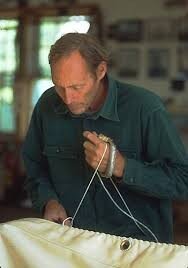HOME THE DREAM PASSAGE ICE BOUND DELIVERANCE LOSS REFLECTION
ICE BOUND
In spite of ice along the Greenland Coast, the weather had been good and the wind light. July 12 had started as another clear day and by afternoon a light southwesterly breeze developed. The crew saw growlers, bergy bits and smaller ice chunks and continued to veer away from what they perceived to be the ice edge. As night fell, the crew encouraged Geoff to get some rest and divided the night watches among themselves. By morning the world of the Sheila Yeates had changed dramatically.
““We were starting to see a few small bergs so we changed course to the south. The air was very light but we were conserving fuel so we didn’t go to engine power, instead opting to wait and see if we’d get some wind.””
“It happened quietly without any drama,” said Mike Metzmaker. “The crew on night watch began to see patches of sea ice and we would steer along their edge. Then more ice appeared but it was loose. At some point the ice began to condense and grow more expansive, so we kept steering away from what appeared to be the edge of the floes. Visibility began to lessen as the fog thickened. We were starting to see a few small bergs so we changed course to the south. The air was very light but we were conserving fuel so we didn’t go to engine power, instead opting to wait and see if we’d get some wind. We had no perception of real danger at the time that suggested a more aggressive action was needed.” said First Mate Rick Palm. “I had this surreal moment. I remember when I went up on the bowsprit to pull down the headsail and just a few hundred feet off, a killer whale breached, and it was like we made eye contact and it went back down. It was almost like this telling thing - like we are getting a warning.”
When the crew woke Geoff in early morning of July 13, visibility was less than 50 yards and the Sheila Yeates was surrounded by sea ice and large bergy bits and growlers, some the size of the boat itself. The southwesterly wind together with an opposing current had probably caused a massive buildup of sea ice around the unsuspecting ship during the night. The directions from Greenland Command may have kept them too close to the ice edge. Whatever the reason, a large mass of sea ice now hemmed in the Sheila Yeates.
As captain, Geoff accepted full responsibility for their predicament. “It’s like flying an airplane,” he said years later. “If a little thing goes wrong and you aren’t on top of it then the next little thing goes wrong and then it spirals out of control.”
Rick Palm
Ice closes in on the Sheila Yeates
“In 36 hours we quietly went from a boat moving along the ice to ice surrounding and moving the boat,” said Mike Metzmaker.
Geoff started the engine and the crew used pike poles to move large ice chunks away from the hull in an effort to maneuver the 50-foot sailboat to open water. They motored down one opening channel after another. Geoff would find one large area of open water and then find there would be no outlet or the ice was too thick to power through. Seals watched from their perch atop the larger ice floes. The crew remained optimistic; joking about which ice floe they would choose to “ride” when abandoning ship.
But they were soon sobered by the sound of large ice chucks crushing against the wooden hull with such a ripping sound that it sent crew members searching for cracks below deck. Luckily there were none yet and there was no water getting into the ship. For the entire day the captain and crew continued to search for an opening that would lead to the ice edge. Finally they could hear the surge of heavy seas that signaled open water not more than half a kilometer away, but as they slowly worked closer to the ice edge, the surge became a roar and no one on board believed that the wooden hull of the Sheila Yeates could withstand the intense grinding action it would take to move through the massive three-meter swell from pack ice to open water. She could be pulverized in the transit.
As the captain and crew weighed their options and made a radio call to Greenland Command, the wind and ocean current continued to pack sea ice around the ship. In a short span of time, their window of opportunity to exit the ice was lost; the opening to the sea closed and the Sheila Yeates became completely trapped once again. The more she struggled to free herself from the ice, the more tightly she was bound. “It became obvious to all of us,” said Metzmaker, that we were not going to get out of this on our own." After a day of trying to free the ship from the drifting sea ice, the wind and currents of the Labrador Sea were now carrying the Sheila Yeates on a separate course. According to Palm, "the Sheila Yeates had become the inner part of the mass, rather than the edge of the mass." "I have never seen a denser white fog in my life," remembered Nat Wilson, "The ocean was a deep navy blue and the ice was white and the fog was even whiter. You could see blue sky above, it was just very strange."
Nat Wilson by Dave Harp
Throughout the day Geoff had been calling in his position to the marine station at Julianehab, Greenland on nearly an hourly basis. There was a heliport located there for search and rescue missions. Now it was time to officially request help. Geoff called and described their situation, gave their position and requested assistance. The response from the station was not what he wanted to hear. The radio dispatcher responded; "œYou are below visibility and beyond the limits of our helicopter range. We cannot send assistance." The Sheila Yeates was on her own floating in pack ice in the Labrador Sea.
Geoff and the crew were stunned. Somehow, up to this point, everyone"™s spirits had remained high and all believed there was a way out. Help would be accessible. But the fact that no helicopter would be sent by Greenland "was sobering news." The crew began to understand the seriousness of their situation. "Dread set in," remembered Palm. The captain of a German freighter had overheard their radio conversation with Julianehab. He called the Sheila Yeates and spoke with Geoff. The crew’s spirits rose until he said that his ship did not have ice-breaking capabilities, so there was no way he could help them. Ten minutes later another freighter contacted the Sheila Yeates. They too had heard Geoff’s request for assistance, but they too, were not equipped to assist a vessel caught in ice. In addition, they warned Geoff of the estimated three-meter swell at the edge of the ice. With the realization that no assistance was forthcoming and the ship was floating farther out of radio range, the mood of the crew turned somber. The ice continued to grate against the wooden hull of the Sheila Yeates. Time and circumstances were running out. The crew pulled out the life rafts and tied them on the deck of the ship. They began to survey the most level ice sheets to use for a possible evacuation, should the hull of the Sheila Yeates be penetrated and flooded. But they all knew they wouldn’t survive for long on the ice. As the second evening watch unfolded, fear set in, deep fear. No one spoke of it but everyone felt it. If help didn’t come soon, Geoff thought to himself, “We are seven dead guys."
“Mayday. Mayday. This is the Sheila Yeates calling any vessel. This is the Sheila Yeates calling any vessel.”
Sometime after midnight on that second night of being trapped in ice, crew-members Mike Metzmaker, Rick Palm and Nat Wilson gathered on deck. Mike had the 11:30 p.m. watch. He had tried to make the hourly call to Greenland Command but he couldn’t reach the station. Rick had joined Mike to help on the watch. Nat was unable to sleep and was getting ready to take over the next watch at 12:30 a.m. The fog was thick as soup. The ice was grinding against the hull of the ship. The men could hear the southerly wind building swells along the outside edge of the ice. There was no change in their icebound predicament. Their fear was palpable but unspoken. They all felt that only one alternative remained. It was time for a Mayday. Without waking Geoff, they went to the VHF radio and Mike picked up the receiver hoping that someone in that vast stretch of the Labrador Sea would hear his call. "Mayday. Mayday. This is the Sheila Yeates calling any vessel. This is the Sheila Yeates calling any vessel. The time is 0015 hours. We are caught in pack ice approximately 49 miles south of Cape Farewell, Greenland; Latitude 59°10.6’ North, Longitude 43°39.0’ West. We are outside helicopter range and below ceiling for Greenland Command. We are in need of rescue. This is a Mayday."





